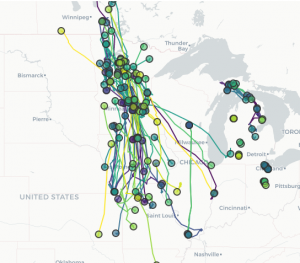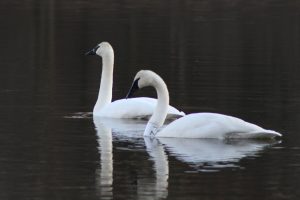Imagine you find yourself outdoors one autumn, somewhere in the Midwestern U.S. The brisk fall wind greets your face as you trek through the painted woods. Oak leaves are a hanging onto branches overhead, fighting to find their final resting place on the forest floor below you. Bright yellow and vibrant red Maple leaves create a mosaic rug as you gaze along the path before you. Natures very own “Red Carpet” guides you to the end of the trail; an inland lake. As you stop to admire the beauty of the golden rays bathing the lake in a sort of glimmering dance, you are interrupted by the sound of wings beating through the air. “PHHUMMP PHHUMMP PHUMMP PHUMMP” and then finally “SPLASHHH”. You shift your attention immediately to the lake, and are gifted with the sight of two beautiful, strong, large white birds. Within a few minutes of landing, the two begin an intense duet of battling bugles, as their heads vigorously bob up and down.
For any birder, this is the moment you know , you are in the presence of one of the most charismatic waterfowl you can find, the Trumpeter Swan (Cygnus buccinator)! As you admire the striking white swans swimming against a backdrop of fall color, you might wonder, “Where do these swans go in the winter? I know geese migrate, but do swans?” Luckily, some extremely dedicated scientists partnered throughout the Midwest to answer that question along with others with a study called “Interior Population Trumpeter Swan Migration Ecology and Conservation.”
Trumpeter Swans are native to the United States, and now have breeding populations throughout the Midwest, including the states of Michigan, Minnesota, Iowa, Ohio, and Wisconsin. However, it was not long ago when an autumn walk by Midwestern lake would’ve been much quieter. In the 1960s, the breeding population along the Mississippi and Atlantic flyways, which the study refers to as the Interior Population, was estimated at less than 3,800 individuals. With extremely hard work by countless dedicated individuals, the Mississippi and Atlantic flyways have slowly been restored to an estimated 27,000 individuals, as of data produced in 2015! Click here to watch a video on how the W.K. Kellogg Bird Sanctuary was involved in reintroducing Trumpeter Swans to Michigan.
So, what does the study of the Trumpeter Swans’ interior population tell us about where they go in the winter? Will they migrate to Florida for the winter like many Michiganders? Well…no. As it turns out, the swans collared in Michigan as a part of this study, mostly stayed for the winter! Out of the 12 Trumpeter Swans collared in Michigan, only two were tracked travelling more than 100km from their summer range! This is an interesting contrast to those in Minnesota, where five of the seven collared Trumpeter Swans flew more than 100km from their summer habitat to winter in states like Missouri and Arkansas. A more detailed look at the Trumpeter Swans’ locations showed that many of the birds who stayed, had opportunity to winter on open waters like large rivers. Here at the W.K. Kellogg Bird Sanctuary, Wintergreen lake is outfitted with several aerators, which ensure our residents have open water all year round! This is likely one reason that we have so many Trumpeter Swans visit us throughout the winter season! If you’d like to learn more about Trumpeter Swans visit the Trumpeter Swan Society.
Brenden Kokx is the Avian Care Support Technician for the W.K. Kellogg Bird Sanctuary. He graduated from Michigan State University in 2020 with a B.S. in Fisheries and Wildlife Management.”



A legacy of conservation; a commitment to sustainability.
Kellogg Bird Sanctuary12685 East C Avenue
Augusta, MI 49012
Phone: (269) 671-2510 birdsanctuary@kbs.msu.edu